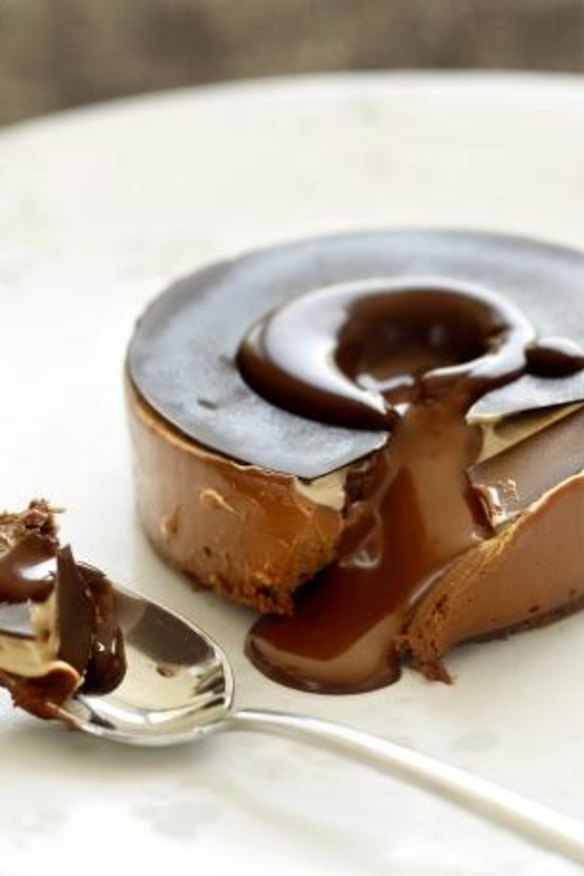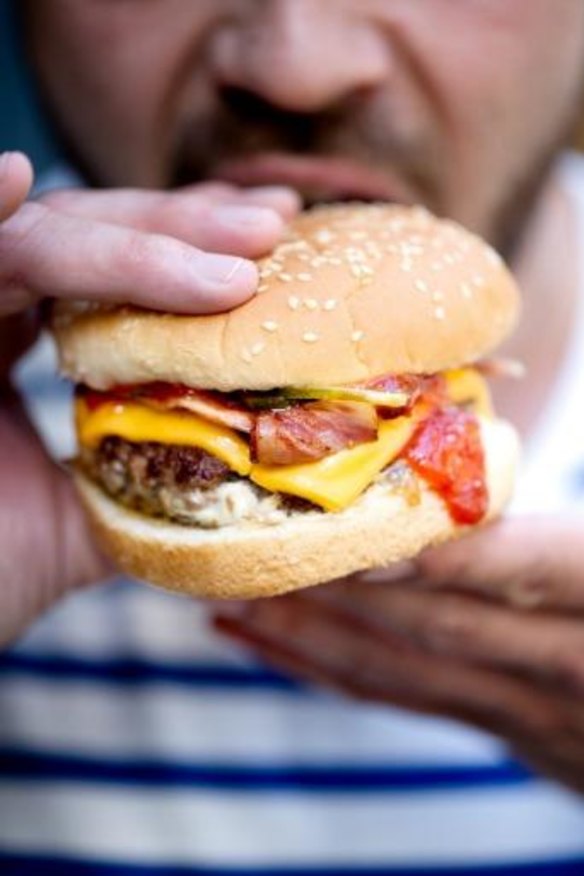The 10 dishes that changed Sydney
When adventurous chefs broke the rules and started fusing French, Asian and Australian cuisine, it shocked out palates, changed our tastes and unleashed the young guns. And this city has never been the same.

Some dishes are more than just dinner. Every now and then, something special comes along that doesn't just nourish and sustain, but moves the earth beneath your feet. Makes you sit up and blink, and wonder what just happened.
A tranche of seemingly raw salmon topped with crunchy kombu, a block of ice-cream in the shape of a chequerboard or an Asian omelette stuffed with spanner crab are not of themselves going to tilt the world on its axis, but I remember the very moment I tried each for the first time. They changed me, and moved my thinking forward. They moved everyone's thinking forward.
Once you have tried Tetsuya's confit of ocean trout, you realise just how natural it is to apply a Japanese sensibility to French technique, creating something with a harmony of its own (and you cannot ever eat over-cooked salmon again). By approaching ice-cream with the eye of a technician/artist, Phillip Searle paved the way for the extreme gelato we take for granted today. And when Neil Perry chose to put a Chinatown favourite on the menu of Rockpool in 1989, it fused not just east and west, old and new, Aussie and Chinese, but sent a clear message to the young gun chefs of the day to break the rules, and start cooking the food they liked to eat. There was no going back after that.

MIANG KHAM
THE CHEF: David Thompson
THE DISH: Fresh betel leaves topped with prawn, roasted coconut, chilli, tamarind, lime, ginger, shallots, peanuts and caramel sauce; a traditional street snack that Thompson first encountered in Thailand in the 1980s.
WHEN & WHERE: Darley Street Thai, Newtown, 1992
BEFORE: Sydney thought Thai food was cheap and cheerful, sweet and mild; all coconut-milk curries and deep-fried curry puffs.
AFTER: Miang kham and Darley Street Thai gave Sydney the taste for real, uncompromised Thai cuisine, shocking them with the wild sensory onslaught of hot, sweet, sour and salty. Without them, there would be no Sailors Thai, no Longrain, no Spice I Am, or Thai food as we know it.
MAGNITUDE OF SEISMIC DISTURBANCE: 8.2. Major, felt throughout all urban areas.
PARIS MASH
THE CHEF: Guillaume Brahimi
THE DISH: A silky emulsion of cold butter and hot potato inspired by Joel Robuchon's legendary puree de pommes de terre from Jamin restaurant in Paris, where Brahimi worked for four years.
WHEN & WHERE: Pond, King's Cross, 1994.
BEFORE: Mash was mash, something watery and often granular that came with your steak in a pub if they didn't do chips.
AFTER: It went ballistic. Suddenly all mash was Paris Mash, with many restaurants copying the name itself, not knowing it was inspired by copies of the French magazine Paris-Match sent to Brahimi by his mother. It lives on today as a generously complementary side to the main courses at Guillaume in Paddington.
MAGNITUDE OF SEISMIC DISTURBANCE: 6.8. Strong. Severe damage to buildings and other structures.
CONFIT OF PETUNA OCEAN TROUT
THE CHEF: Tetsuya Wakuda
THE DISH: Petuna ocean trout from Tasmania cooked in olive oil at 50C, sliced and served topped with crisp kombu, accompanied by parsley oil, fennel salad and ocean trout roe.
WHEN & WHERE: Tetsuya's, Rozelle, 1992
BEFORE: The French cooked fish, the Japanese served it raw. This was a fusion of the two, miraculously appearing raw but tasting cooked, leaving the mouth with a seductively rich and oily after-glow.
AFTER: By blending Japanese aesthetic with classic French technique in the spirit of nouvelle cuisine, Wakuda created a unique new style that paved the way for young Australian chefs to take inspiration from Asia, not just France.
MAGNITUDE OF SEISMIC DISTURBANCE: 10. A rift in the time/space continuum.
CHEQUERBOARD ICE-CREAM
THE DISH: Pineapple sorbet and star anise ice-cream bordered with licorice gel and served in the form of a chequerboard, ungarnished and unsauced.
THE CHEF: Phillip Searle
WHEN & WHERE: Oasis Seros, Paddington, 1988
BEFORE: It was a time of overly ornamental, suburban desserts, lots of pastry, lots of creme anglaise.
AFTER: The precision of the construction, the artistry of the whiter-shades-of-pale, the harmony and juxtaposition of the flavours. Licorice! Star anise! We'd never seen such a thing. Without it, we wouldn't have the genius desserts of Christine Manfield; nor, perhaps, the madness that is Gelato Messina.
MAGNITUDE OF SEISMIC DISTURBANCE: 7.7 Major, few structures left standing.
EIGHT-TEXTURE CHOCOLATE CAKE
THE CHEF: PETER GILMORE
THE DISH: Chocolate cake, chocolate mousse, chocolate and hazelnut meringue, chocolate caramel ganache, praline chocolate, chocolate whipped cream, tempered chocolate disc, brought together by an act of pure theatre, as hot chocolate sauce is poured on top, and the whole thing trembles, melts, and gives way.
WHEN & WHERE: Quay, Circular Quay, 2009, for the restaurant's eighth anniversary, having grown from five textures at De Beers, Whale Beach, in 2000, and four textures before that.
BEFORE: Few desserts showed such technique. This was a complete technical control exercise in temperature, timing and tempering.
AFTER: By aiming for perfection, Gilmore brought new heights of glamour, construction and drama to what was once the domain of good old chocolate mousse. I suspect it changed how every pastry chef in Australia saw their role, overnight.
MAGNITUDE OF SEISMIC DISTURBANCE: 6.9 Very strong, followed by a second tremor in 2009: The Snow Egg.
STIR-FRIED SPANNER CRAB OMELETTE
THE CHEF: Neil Perry
THE DISH: A killer combo of wok-fried omelette folded over sweet crab meat, bean sprouts and yellow chives, painted with oyster sauce and bathed in chicken broth.
WHEN & WHERE: Rockpool, The Rocks, 1989
BEFORE: There were combination seafood omelettes in Chinese restaurants, but nothing like this, done by a hot young Australian chef with a real understanding of Chinese food.
AFTER: With its emphasis on freshness, big flavours, Asian technique, and great Australian seafood, it quickly became the face of Modern Australian dining, and one of the most-copied dishes in Sydney.
MAGNITUDE OF SEISMIC DISTURBANCE: 5.5. No immediate damage, but effects felt over a long period.
FRIED SALTBUSH CAKES
THE CHEF: KYLIE KWONG
THE DISH: Plump fried saltbush cakes, a play on northern Chinese spring onion pancakes. Soft, crisp, flaky pastry outside; glossy, salty, incredibly buttery saltbush and tatsoi leaves inside.
WHEN & WHERE: Billy Kwong, Surry Hills, 2013
BEFORE: Random sightings of native ingredients (Bar H, Marque, etc), after an enthusiastic wave of "bush tucker" excitement in the 1980s died away.
AFTER: By incorporating native Australian ingredients into her own special brand of Aussie/Chinese cooking, Kwong gave her food authenticity and meaning, simultaneously putting pressure on her peers to make their food more Australian.
MAGNITUDE OF SEISMIC DISTURBANCE: 7.4. Major, affecting long-established structures.
MOMOFUKU PORK BUN
THE CHEF: David Chang
THE DISH: Chinese steamed bun stuffed with roast pork belly, quick-cured cucumber, spring onions and Sriracha chilli sauce, an eleventh hour addition to the menu for the first Momofuku Noodle Bar in New York in 2004 by founder David Chang.
WHEN & WHERE: Momofuku Seiobo, Pyrmont, 2010
BEFORE: We knew about Dave Chang, and we knew about steamed buns, but we had no idea how good it would be when the two got together in Sydney.
AFTER: Introduced hand-held eating to fine dining. Pushed forward the trend for something-meltingly-fatty-within-ethnic-bread. Re-wrote the bar menu.
MAGNITUDE OF SEISMIC DISTURBANCE: 7.6. Major. Buildings displaced, underground pipes broken.
BILLS SCRAMBLED EGGS
THE CHEF: Bill Granger
THE DISH: Not actually "scrambled", the eggs are mixed with cream and gently moved around a non-stick pan until they form mousse-like curds of indescribable creaminess.
WHEN & WHERE: bills, Darlinghurst, 1992
BEFORE: Eggs were eggs, and scrambled eggs in particular were over-cooked rubble; something to avoid. Few chefs applied serious technique and style to the art of breakfast, something left in the hands of casual short-order cooks.
AFTER: Granger's fresh, simple, market-driven mantra changed the cafe as we know it, and particularly changed how we cook something as simple and as fundamental as eggs. When the New York Times referred to them as "the best scrambled eggs in the world", Sydney's sunny attitude to food hit the world stage.
MAGNITUDE OF SEISMIC DISTURBANCE: 9.5. Maximum damage sustained over long period.
THE LOTUS BURGER
THE DISH: Soft bun, miso-caramelised onions, all-beef patty, processed cheese, char-grilled bacon, pickles, and tomato ketchup – yep, a burger.
THE CHEF: Dan Hong
WHEN & WHERE: Lotus, Potts Point, 2008.
BEFORE: Burgers were what you went out for after drinking too much, not what you went out to dinner for.
AFTER: Putting a streetwise burger on the menu of an otherwise fine-dining establishment was like a de-restriction sign for the next generation of chefs that announced "No more speed limits, you can mix it up, drink beer, have fun, and do your own thing". Dude food had definitely landed.
MAGNITUDE OF SEISMIC DISTURBANCE: 6.2. Mostly felt in populated areas.
RECIPES
Neil Perry's stir-fried spanner crab omelette
Serves 4 as part of a shared meal
5 x 55g eggs
1 tbsp palm sugar
1 tbsp fish sauce
200g spanner crab meat
100g beansprouts
50g snowpea sprouts
15 Chinese yellow chives, washed and halved
150ml peanut or vegetable oil
4 tbsp oyster sauce
For the broth:
150ml chicken stock
3 tbsp palm sugar
2 tbsp fish sauce
1 tsp sesame oil
To make the broth, combine all the ingredients except the sesame oil in a pot. Bring to the boil, pour in the sesame oil, and keep warm.
Beat the eggs in a medium-sized bowl. In a small bowl, dissolve the palm sugar in the fish sauce. Add to the eggs and whisk well.
Pick through the crabmeat and discard any cartilage and shell. Add the beansprouts, snowpea sprouts and chives, and mix well.
Place the oil in a wok and heat until it is smoking. Pour in the egg mixture (it should puff up). Cook for 3 minutes, then place the crab mixture in the middle. Cook for a further 3 minutes and remove from the heat.
Pour off the excess oil. Fold the omelette, and place it back in the wok for 1 minute. Turn off the heat and rest it near a heat source for a further 2 minutes.
Remove the omelette from the wok with a fish lifter and place on a board. Trim off the ends and place in a large bowl. Pour over the hot broth, top with oyster sauce and serve.
Guillaume Brahimi's Paris mash
Serves 4
4 large (around 600g) desiree potatoes, unpeeled
fine sea salt
200ml milk
200g cold unsalted butter, diced
Place the unpeeled potatoes in a large saucepan and cover with cold water. Add a pinch of salt and bring to the boil, then reduce the heat and simmer for 25–30 minutes. (Test the potatoes by piercing them with a sharp knife. If they are ready, the blade will come out clean with no residue.) Drain well.
Peel the potatoes while they are still hot, using a tea towel to protect your hands. Pass the peeled potatoes first through a mouli, and then through a tamis (flat drum sieve) into a saucepan set over low heat. Using a wooden spoon, stir the mash until all the moisture is removed, it needs to be dry to the touch.
Bring the milk to the boil, then reduce the heat to a simmer. Place the mashed potato over low heat and add 50 grams of butter, beating until combined. Add 50 millilitres of milk and beat until combined. Repeat until all of the butter and milk has been added and the mash is creamy and light. Season with salt to taste, and serve.
Restaurant reviews, news and the hottest openings served to your inbox.
Sign up